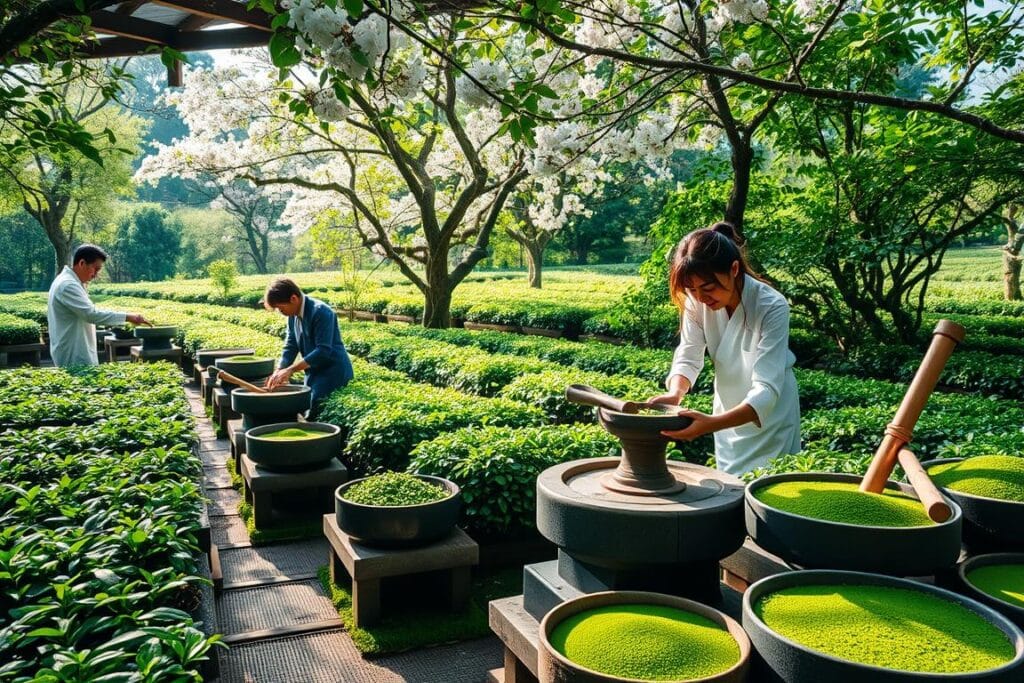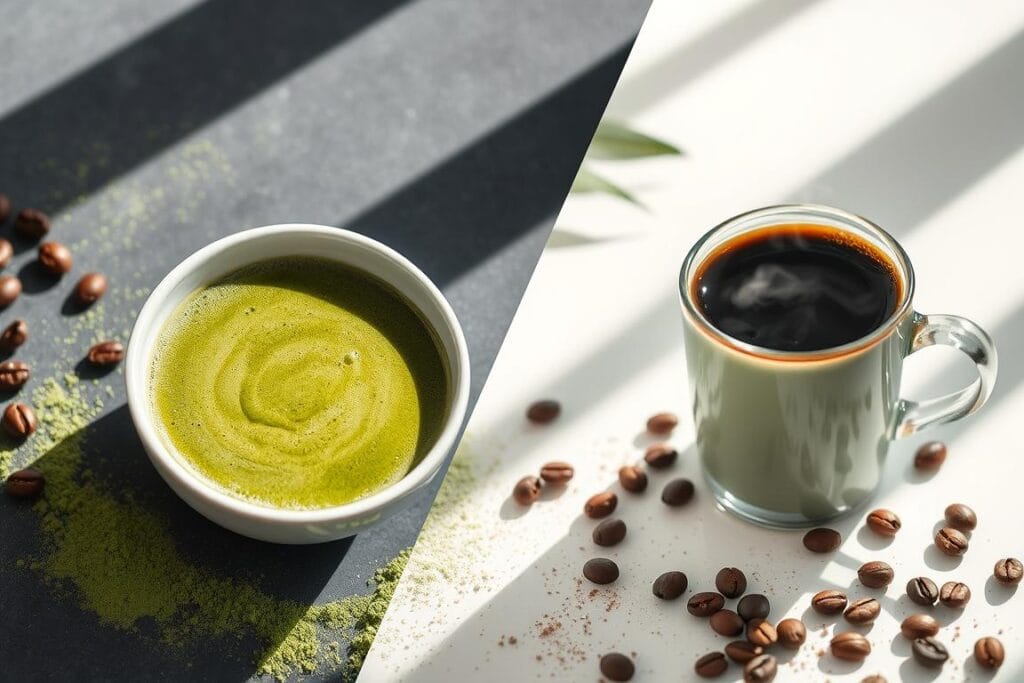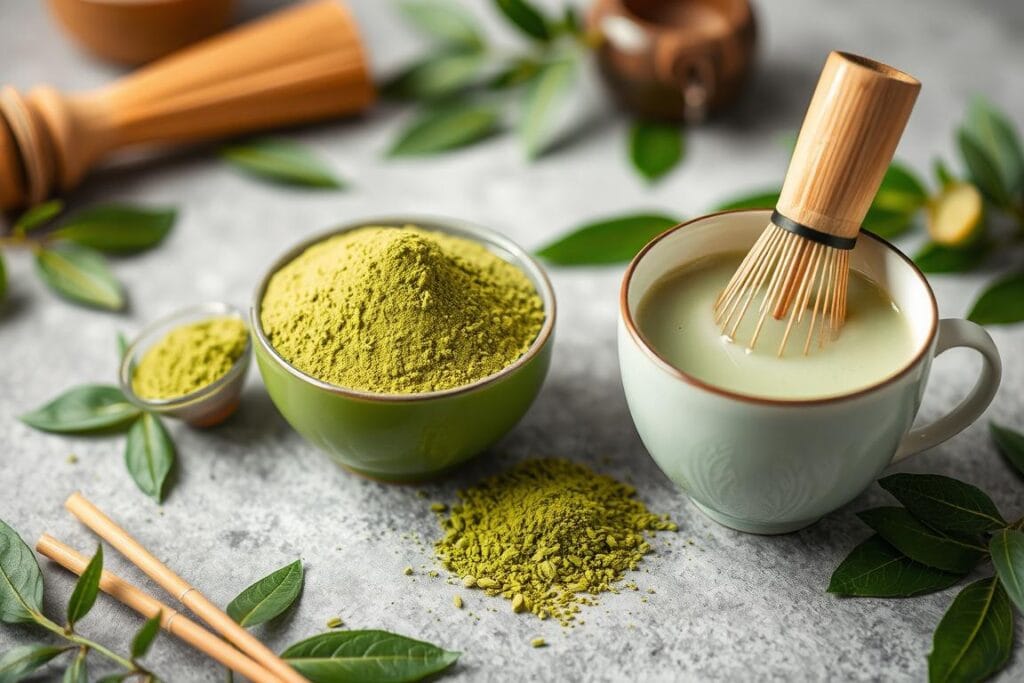Key Takeaways
- Matcha contains 20-45mg of caffeine per gram
- Offers longer-lasting alertness compared to coffee
- Provides sustained energy without typical caffeine jitters
- High-quality matcha delivers more consistent caffeine levels
- Supports mental clarity and physical performance
Understanding Matcha: Origins and Production
Matcha is a special green tea with deep roots in Japanese culture. It’s a vibrant powder made from centuries of tea cultivation. This process turns simple tea leaves into a nutritional powerhouse.

Traditional Japanese Processing Methods
Japanese matcha production is unique. It starts with carefully chosen Camellia sinensis plants. These plants are grown for the highest quality green tea powder.
- Leaves are hand-picked from designated tea fields
- Young, tender leaves are selected for ceremonial grade matcha
- Leaves undergo meticulous sorting and processing
The Importance of Tea Grade Quality
Not all matcha is the same. Ceremonial grade matcha is the best, known for its vibrant green color and smooth taste. It also has a high nutritional value.
“The quality of matcha is determined by its color, texture, and flavor – true excellence cannot be compromised.”
Learn more about matcha’s exceptional qualities in this guide on sweet potato and bacon casserole as a flavorful comfort dish.
Shade-Growing Technique Impact on Caffeine
The shade-grown tea leaves technique changes the tea’s chemical makeup. Tea plants are covered with screens for weeks before harvest. This increases chlorophyll, L-theanine, and caffeine.
| Matcha Grade | Shade Duration | Caffeine Level |
|---|---|---|
| Ceremonial Grade | 20-30 days | High |
| Culinary Grade | 10-20 days | Moderate |
This careful process turns regular tea leaves into a special drink. It’s packed with nutrients and has a unique flavor that’s loved worldwide.
Caffeine Content in Matcha vs Coffee
Learning about the caffeine in matcha and coffee can change how you manage your energy. Both drinks give you a caffeine kick, but they affect your body in different ways.

Breaking Down the Numbers
The amount of caffeine in matcha and coffee is different. A teaspoon of matcha has about 60-70 mg of caffeine. Coffee usually has 80-100 mg per cup. The main difference is how your body absorbs and feels this caffeine.
| Beverage | Caffeine Range (mg) | Absorption Characteristics |
|---|---|---|
| Matcha | 19-44 mg per gram | Slow, sustained release |
| Coffee | 80-100 mg per cup | Quick, intense spike |
Absorption Rates and Duration
Matcha’s caffeine absorption is special compared to coffee. The caffeine in matcha is tied to catechins. This leads to a sustained energy release that lasts 6-8 hours. Coffee’s effect is shorter, lasting 3-4 hours.
Check out the benefits of soaking ingredients in this article: Why does sweet potato casserole get watery?.
Impact on Energy Levels
- Provides balanced energy without jitters
- Promotes calm alertness through L-theanine
- Supports steady mental focus
“Matcha offers a more harmonious caffeine experience, combining alertness with relaxation.”
Knowing about caffeine absorption helps you choose the right drink for your energy needs.
The Science Behind Matcha’s Unique Caffeine
Matcha’s caffeine is different from other drinks. It gives you a special energy boost that lasts longer than usual. This is because matcha’s caffeine is released slowly, keeping your mind clear for hours.
Matcha’s secret is in its molecular makeup. Catechins, strong antioxidants, help control how caffeine is absorbed. They make sure the caffeine is absorbed slowly, giving you:
- Steady energy without sudden crashes
- Reduced adrenaline spikes
- Balanced glucose levels
- Smooth cognitive enhancement
Studies show matcha’s caffeine works differently in your body. The slow release means you stay focused without the jitters coffee can cause.
“Matcha transforms caffeine intake from a sharp burst to a gentle, sustained wave of mental alertness.” – Nutrition Science Journal
This special way caffeine is absorbed in matcha is good for your body. It helps you stay energized and focused, supporting both your body and mind.
L-Theanine: Matcha’s Secret Energy Weapon
Matcha green tea is special because it combines L-theanine and caffeine. This mix changes how we feel energy and focus.
The Science of Calm Energy
L-theanine does more than just relax you. It works with caffeine to balance your mind. Unlike other caffeine, matcha gives you steady energy.
- Reduces stress without causing drowsiness
- Enhances cognitive performance
- Promotes relaxed alertness
Synergistic Caffeine Effects Explained
L-theanine and caffeine together create something amazing. They make you feel focused and calm, unlike energy drinks.
| Benefit | L-Theanine Impact |
|---|---|
| Mental Clarity | Improves focus without jitters |
| Stress Reduction | Lowers anxiety levels |
| Cognitive Enhancement | Boosts mental performance |
“L-theanine transforms caffeine from a simple stimulant into a sophisticated cognitive tool.” – Nutrition Research Institute
Your brain gets into a calm yet alert state. The L-theanine and caffeine mix keeps you sharp and focused all day. This makes matcha different from other caffeinated drinks.
Health Benefits Beyond the Caffeine Boost
Matcha is more than a tasty drink; it’s a health powerhouse. It’s full of matcha antioxidants, making it a nutritional superstar. This green tea can change your wellness game.
Matcha’s green tea benefits are amazing. Here are some cool facts:
- A single cup of matcha has as much nutrition as 10 cups of regular green tea
- Matcha has over 100 times more catechins (antioxidants) than other green teas
- It beats superfoods like spinach, broccoli, and blueberries in antioxidants
EGCG, a key catechin in matcha, is great for health. Studies show it can:
- Help your heart by lowering disease risks
- Support weight management
- Protect cells from damage
“Matcha is nature’s multivitamin in a cup” – Wellness Experts
Matcha also has chlorophyll, which detoxifies and makes your skin glow. It’s not just a trendy drink; it’s a whole wellness package.
| Matcha Benefit | Key Impact |
|---|---|
| Antioxidant Protection | Fights free radicals and supports cellular health |
| Metabolism Support | Assists in calorie burning without raising heart rate |
| Potential Cancer Prevention | EGCG may help protect against certain cancer developments |
Looking for a nutritious drink? Matcha is a tasty and healthy choice. It can make your daily routine better.
Matcha Brownies: A Delicious Way to Enjoy Your Caffeine Fix
Looking for a sweet treat that’s also good for you? Matcha brownies are the answer. They mix indulgence with wellness, turning the classic brownie into a healthier delight.
Matcha baking opens up new tasty options. Your brownies can now be a source of antioxidants and a gentle caffeine kick.
Recipe Tips and Techniques
To make the best matcha brownies, follow these tips:
- Choose high-quality ceremonial-grade matcha powder
- Sift matcha to prevent clumping
- Balance matcha’s earthy flavor with rich chocolate
- Use alternative flour for gluten-free options
Nutritional Benefits of Matcha Desserts
Matcha brownies take healthy baking to the next level. They offer more than just taste:
| Nutrient | Benefit |
|---|---|
| Antioxidants | Fights free radicals |
| Caffeine | Provides gentle energy boost |
| L-Theanine | Promotes calm focus |
“Matcha brownies prove that dessert can be both delicious and nutritious!” – Wellness Foodie Magazine
Try new things with your matcha brownie recipe. Make a dessert that’s good for you and tastes amazing.
Proper Matcha Preparation Methods
Mastering the art of matcha tea ceremony needs precision and care. Whether you’re making a traditional drink or a modern matcha latte, knowing the right techniques can make a big difference.
When whisking matcha, start by picking the right powder grade. Ceremonial-grade matcha is the best for drinking. Culinary-grade is better for lattes and baking.
Essential Preparation Steps
- Sift 1-2 teaspoons of matcha powder to remove clumps
- Use water at 80°C (176°F) to prevent bitterness
- Whisk in a zigzag motion using a traditional bamboo whisk
- Aim for a smooth, frothy consistency
To make a great matcha latte, mix the powder with a bit of hot water first. Then add steamed milk. The goal is to avoid lumps and get a rich, creamy texture.
| Matcha Grade | Best Use | Flavor Profile |
|---|---|---|
| Ceremonial | Traditional Tea | Smooth, Delicate |
| Premium | High-Quality Drinks | Fresh, Vibrant |
| Culinary | Baking & Lattes | Bold, Robust |
“The secret to perfect matcha is patience and technique.” – Japanese Tea Master
Try different ways to prepare matcha to find your favorite. Whether you like it hot, cold, or in a latte, the right method makes a big difference.
Best Times to Consume Matcha for Optimal Energy
Discovering the perfect time to drink matcha can change how you manage your energy. Matcha helps keep you focused and energized all day. Drinking it at the right times works better than drinking it randomly.
Your body reacts differently to matcha at different times. It’s important to know when to enjoy this powerful green tea.
Morning Matcha Ritual
Begin your day with a pre-workout matcha to get energized. The mix of caffeine and L-theanine gives you a steady energy boost. This boost is smooth and doesn’t make you feel jittery like coffee does.
- Recommended morning intake: 1 teaspoon of ceremonial-grade matcha
- Best consumed 30-45 minutes before morning activities
- Provides gentle, balanced energy for morning workouts
Afternoon Energy Boost
When you start to feel tired in the afternoon, matcha can be your ally. Unlike coffee, matcha gives you a balanced energy boost without sudden spikes.
- Ideal time: Between 2-4 PM
- Helps maintain productivity without disrupting sleep patterns
- Approximately 1/2 teaspoon of matcha recommended
*”Matcha is not just a drink, it’s a strategic energy management tool.”*
Pre-Workout Performance Enhancement
Athletes and fitness lovers are finding matcha great for workouts. Its special nutrients help with endurance and focus during exercise.
- Consume 30 minutes before workout
- Enhances mental clarity and physical performance
- Supports metabolism and fat oxidation
Knowing how your body reacts to matcha can help you stay energized all day. Try different times to find when matcha works best for you.
Conclusion
Switching to matcha is a smart move for your health and energy. This green tea powder gives you sustained energy and wellness benefits. It’s a natural alternative that boosts both mental clarity and physical vitality.
Matcha is more than just a drink. It’s used in traditional tea and even in foods like matcha brownies. It offers a balanced energy boost without the jitters or crash of coffee.
Scientific studies show matcha’s amazing properties. It’s full of antioxidants and nutrients that support metabolism and cognitive function. It’s a natural energy source that can improve your daily routine.
Choosing matcha means embracing a tradition of holistic health from Japan. Start your matcha journey today and see its incredible benefits for yourself.

